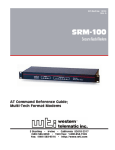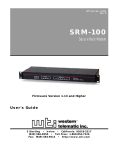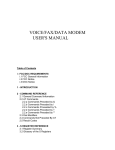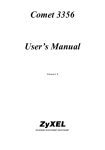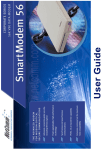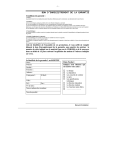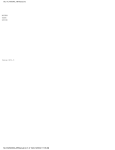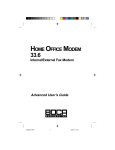Download Western Telematic SRM-100 User`s guide
Transcript
WTI Part No.: 13132 Rev. A SRM-100 Secure Rack Modem AT Command Reference Guide; Rockwell Format Modems 5 Sterling · Irvine · California 92618-2517 (949) 586-9950 · Toll Free: 1-800-854-7226 Fax: (949) 583-9514 · http://www.wti.com Table of Contents 1. Introduction . . . . . . . . . . . . . . . . . . . . . . . . . . . . . . . . . . . . . . . . . . . . . 1-1 2. Communicating with the Internal Modem . . . . . . . . . . . . . . . . . . . . . . . . . . . 2-1 3. Modem Status . . . . . . . . . . . . . . . . . . . . . . . . . . . . . . . . . . . . . . . . . . . . 3-1 4. AT Command Set . . . . . . . . . . . . . . . . . . . . . . . . . . . . . . . . . . . . . . . . . . 4-1 5. S-Registers . . . . . . . . . . . . . . . . . . . . . . . . . . . . . . . . . . . . . . . . . . . . . . 5-1 6. Modem Result Codes . . . . . . . . . . . . . . . . . . . . . . . . . . . . . . . . . . . . . . . 6-1 List of Figures 1. The Modem Status Screen (Defaults Shown) . . . . . . . . . . . . . . . . . . . . . . . . . 3-1 i 1. Introduction The SRM-100 Secure Rack Modem is designed for applications that require secure, dial-up access to console ports on rack mounted equipment. WTI's Secure Rack Modem can recognize up to 100 passwords, track activity for each password and create a log record of successful and/or unsuccessful access attempts. In addition to the SRM's Menu Driven configuration functions, the internal modem will also accept AT commands. This document describes the AT command set for Rockwell format modems, and lists the function of each command. If necessary, the AT command can be used to select advanced modem configuration parameters, some of which may not be available via the SRM's menuing system. AT commands can be sent directly to the modem, or added to the user defined initialization string via the SRM's Modem Parameters menu. Note: For information on general SRM-100 installation, configuration, and operation procedures, please refer to the SRM-100 User's Guide (WTI P/N 13051). About this Document This document describes the AT Command Set, S-Register configuration, and Modem Response Codes for all SRM-100 units that include the Rockwell format modem. Depending on when you purchased your SRM, it may include either a Rockwell format modem or a Multi-Tech format modem. In order to determine which modem is included in your SRM unit, please refer to the SRM-100 Help Screen (/H); locate the field that lists the Modem Type, and then refer to the table below. Listed Modem Type Modem Format V.2000-V34_ACF_DP1 Rockwell Format MT2834ZPX Multi-Tech Format 1-1 2. Communicating with the Internal Modem In order to invoke AT commands, you must communicate directly with the SRM's internal modem. The Modem Command mode is only available via the Console Port or the serial modem port; inbound callers cannot communicate directly with the modem. To send AT commands to the SRM's internal modem proceed as follows: 1. Via Console Port: Access the SRM command Mode as described in Section 5.1.1 in the SRM-100 User's Guide. a) When the "SRM>" command prompt appears, type /U and press [Enter] to display the SRM Utilities Screen. b) When the Utilities Screen appears, type 8 and press [Enter] to activate the PassThrough mode. When the Pass-Through Mode is active, the device connected to the Console Port can send AT commands directly to the SRM's internal modem. c) To exit the Pass-Through Mode, type /X and press [Enter], the unit will return to the "SRM>" command prompt. 2. Via Modem Port: The device connected to the SRM's Modem Port can also issue AT commands. Go to the secure device and start your communications program (e.g. ProComm). Make certain that the communications program is configured to use the same COM port that is connected to the SRM. 2-1 3. Modem Status The SRM's internal modem can generate a status screen, which lists currently selected settings for most of the AT commands, the contents of most of the S-Registers, the two stored modem profiles, and four stored phone numbers. To display the modem status screen, access the internal modem's command mode (as described in Section 9.1, in the SRM-100 User's Guide), then type AT&V and press [Enter]. The internal modem will display the status screen shown in Figure 1 below. ACTIVE PROFILE B1 E0 L1 M1 N1 Q1 T V1 W0 X4 Y0 &C1 &D2 &G0 &J0 &K3 &Q5 &R1 &S0 &T5 &X0 &Y0 S00:001 S01:000 S02:043 S03:013 S04:010 S05:008 S06:002 S07:050 S08:002 S09:006 S10:014 S11:095 S12:050 S18:000 S25:005 S26:001 S36:007 S37:000 S38:020 S44:020 S46:138 S48:007 S95:000 STORED PROFILE 0 B1 E1 L1 M1 N1 Q0 T V1 W0 X4 Y0 &C1 &D2 &G0 &J0 &K3 &Q5 &R1 &S0 &T5 &X0 S00:000 S02:043 S06:002 S07:050 S08:002 S09:006 S10:014 S11:095 S12:050 S18:000 S36:007 S37:000 S40:104 S41:195 S46:138 S95:000 STORED PROFILE 1 B1 E1 L1 M1 N1 Q0 T V1 W0 X4 Y0 &C1 &D2 &G0 &J0 &K3 &Q5 &R1 &S0 &T5 &X0 S00:000 S02:043 S06:002 S07:050 S08:002 S09:006 S10:014 S11:095 S12:050 S18:000 S36:007 S37:000 S40:104 S41:195 S46:138 S95:000 TELEPHONE NUMBERS 0= 2= 1= 3= Figure 1: The Modem Status Screen (Defaults Shown) 3-1 4. AT Command Set This section describes the AT command set. Note the following: · Type commands in either upper or lower case. Do not use a combination of upper and lower case characters. · Use the Backspace key to delete errors. · Some commands have numeric options. If these commands are invoked without a numeric option, the modem will assume option 0 (zero). For example, when the command ATE is invoked, the modem will assume command ATE0 was intended. · All commands begin with the AT prefix, and are invoked by pressing [Enter] (Carriage Return). The only exceptions are the A/ command (Repeat previous command) and +++ (Exit to on-line command mode). · The maximum command length is 40 characters. This does not include the AT prefix, Carriage Returns, or spaces. · Defaults are marked with an asterisk (*). Command Function/Options AT Attention Command. Required prefix for all modem commands. Not required for the A/ command or +++ command. A/ Re-execute Last Command. Used mainly to redial. Does not require the AT prefix or a Carriage Return. A Manual Answer. Goes off hook in answer mode. Bn CCITT or Bell Operation B0 Selects CCITT operation at 300 or 1200 bps. * B1 Selects Bell operation at 300 or 1200 bps. Cn Transmit Carrier Signal C0 Not Supported. C1 Enable Transmit Carrier Signal. 4-1 SRM-100 - AT Command Reference Guide; Rockwell Format Command AT Command Set Function/Options Dn Dial Command. Dials the specified phone number. Can also include the following command options: * Dials the “star” digit (tone dialing only). # Dials the “pound” digit (tone dialing only). L Re-dials last number dialed P Pulse (Rotary) Dial Mode. 10 pulses per second. T Tone Dial Mode (DTMF). W Wait for dial tone (1 to 255 seconds, Default = 50 sec.) , (Comma) Pause. Modem will pause for time period specified by register S8 before dialing (0 to 255 seconds, Default = 2 sec.) @ Wait for quiet answer. ! (Exclamation Point) Flashes the switch hook. ; (Semicolon) Return to Command Mode after dialing. & Wait for credit card dial tone before continuing with dial string. If the bong is not detected within the time specified by register S7, the modem will abort the dial sequence, go on-hook, and generate an error message. ^ Toggles calling tone for current dial attempt only. S=n Dial stored number (where n = 0 to 3). () (Parentheses) Ignored; may be used to format the dial string. (Dash) Ignored; may be used to format the dial string. <Space> Ignored; may be used to format the dial string. En Set Local Echo. * E0 Disable echoing of commands to screen. E1 Enable echoing of commands to screen. Hn Disconnect (Hang-Up) H0 Hangs Up (goes on-hook). H1 Goes off-hook. In Modem Identification I0 Display product identification code. I1 Display checksum. I2 Display ROM checksum as OK or ERROR. I3 Display modem firmware revision level. I6 Report modem data pump and internal code revision. Ln Modem Speaker Volume L0 OFF or low volume. * L1 Low volume. L2 Medium volume. L3 High volume. 4-2 SRM-100 - AT Command Reference Guide; Rockwell Format Command AT Command Set Function/Options Mn Modem Speaker Control M0 Disable Modem Speaker. * M1 Speaker ON until carrier is detected. M2 Speaker always ON. M3 Speaker ON after dial, until connection is established. Nn Enable/Disable Automode N0 Disable automode detection (equivalent to setting the +MS<automode> subparameter to 0). A subsequent handshake will be conducted as specified by register S37, or if S37=0, according to the most recently sensed DTE speed. * N1 Enable automode detection (equivalent to setting +MS<automode> subparameters to 1). A subsequent handshake will be conducted as specified by register S37, or if S37=0, starting at 28,800 bps V.34. Notes: • The Nn and S37=x commands override the +MS command settings. When the N0 or N1 command is issued, the +MS subparameters are updated accordingly. For example, “N1S37=10” updates the +MS command subparameters to reflect “+MS=10,1,300,12000”; while “N0S37=10” updates the +MS command subparameters to “+MS=10,0,300,12000”. • It is recommended to use the +MS commands instead of the Nn and S37=x commands. • Nn and S37=x commands are supported for compatibility with existing communication software. On P Qn Sr=n Sr? T Return to On-Line Mode. O0 Switches modem from command mode to on-line mode after dropping to command mode using the escape sequence (+++). O1 Switches from command mode to on-line mode and initiates an equalizer retrain sequence before returning to on-line mode. Set Pulse Dial as Default. Forces pulse dialing until the next T dial modifier or T command is received. Enable/Disable Result Codes Q0 Enable result codes. * Q1 Disable result codes (quiet mode). Set Register r to Value n. See list of S-Registers in Section 10. Display Current Value of Register r. Sets Tone Dial as Default. Forces tone dialing until the next P dial modifier or P command is received. 4-3 SRM-100 - AT Command Reference Guide; Rockwell Format Command AT Command Set Function/Options Vn Result Code Format. * V0 Numeric format. V1 Verbal format. Wn Error Correction Message Control. * W0 Upon connection, modem reports DTE speed only. W1 Upon connection, modem reports line speed, error correction protocol, and DTE speed. W2 Upon connection, modem reports DCE speed. Xn Extended Result Codes. X0 Disables monitoring of busy tones unless forced by country requirements; sends only OK, CONNECT, RING, NO CARRIER, ERROR, and NO ANSWER result codes. X1 Disables monitoring of busy tones unless forced by country requirements; sends only OK, CONNECT, RING, NO CARRIER, ERROR, NO ANSWER, and CONNECT XXXX result codes. X2 Disables monitoring of busy tones unless forced by country requirements; sends only OK, CONNECT, RING, NO CARRIER, ERROR, DIAL TONE, NO ANSWER, and CONNECT XXXX result codes. X3 Enables monitoring of busy tones; sends only OK, CONNECT, RING, NO CARRIER, ERROR, NO DIALTONE, NO ANSWER, and CONNECT XXXX result codes. * X4 Enables monitoring of busy tones and sends all messages. Yn Enable/Disable Long Space Disconnect. * Y0 Disable long space disconnect. Y1 Enable long space connect. Zn Soft Reset and Restore Profile. * Z0 Restores stored profile 0. Z1 Restores stored profile 1. +++ Escape Sequence. Switches from on-line mode to command mode while preserving the connection with the on-line modem. &Cn Controls Data Carrier Detect (DCD) Signal. &C0 Forces DCD signal to be ON at all times. * &C1 Normal DCD operation (required by most software). 4-4 SRM-100 - AT Command Reference Guide; Rockwell Format Command AT Command Set Function/Options &Dn Control Data Terminal Ready (DTR) Signal. Interprets the ON to OFF transition of the DTR signal from the DTE as specified by the &Qn setting. &D0 &Q0,5,6: DTR ignored. &Q1,4: Modem hangs up; auto answer not effected. &Q2,3: Modem hangs up; auto answer inhibited &D1 &Q0,1,4-6: Asynchronous escape sequence. &Q2,3: Modem hangs up; auto answer inhibited. * &D2 &Q0-6: Modem hangs up; auto answer inhibited. &D3 &Q0,1,4-6: Modem performs soft reset as if the ATZ command were received. &Q2,3: Modem hangs up; auto answer inhibited. &Fn Load Factory Defaults. Instructs the modem to load the factory set parameters (non-programmable). &F0 Load factory defaults 0. &F1 Load factory defaults 1. &Gn Select Guard * &G0 &G1 &G2 &Jn Telephone Jack Control. * &J0 No Function. Included for compatibility. &J1 No Function. Included for compatibility. &Kn DTE/Modem Flow Control. &K0 Disable flow control. * &K3 Enable RTS/CTS. &K4 Enable XON/XOFF. &K5 Enable transparent XON/XOFF. &K6 Enable both RTS/CTS and XON/XOFF &Pn Select Pulse * &P0 &P1 &P2 &P3 &Qn Asynchronous Mode &Q0 Direct Asynchronous Mode. All Error Correction and Compression protocols are disabled. This requires that the software’s baud rate matches modem baud rate. * &Q5 Modem negotiates an error correction link. &Q6 Selects asynchronous operation in normal mode. (Speed buffering allows software baud rate to be fixed). Tone. Disable guard tone. Disable guard tone. Select 1800 Hz guard tone. Dial Make/Break Ratio. USA/Canada ratio (39/61 at 10 pps). UK/Hong Kong ratio (33/67 at 10 pps). Same as &P0, except at 20 pps. Same as &P1, except at 20 pps. 4-5 SRM-100 - AT Command Reference Guide; Rockwell Format Command AT Command Set Function/Options &Rn RTS/CTS Option. &R0 In sync mode, CTS tracks the state of the RTS signal; the RTS-to-CTS delay is defined by register S26. In async mode, the CTS signal acts according to V.25bis handshake. * &R1 In sync mode, CTS is always ON (RTS transition is ignored). In async mode, CTS will only drop if required by flow control. &Sn Data Set Ready (DSR) Signal. * &S0 DSR override; always ON. &S1 DSR signal ON after answer tone is detected, and OFF after the carrier is lost. &Tn Test and Diagnostics. Modem will perform selected test and diagnostic function. Note that Tests can only be run in asynchronous mode, with error correction disabled. &T0 Terminate test in progress. &T1 Execute local Analog Loopback Test. &T3 Execute Local Digital Loopback Test. &T4 Enable modem to accept remote request for Digital Loopback Test. * &T5 Deny remote request for Digital Loopback Test. &T6 Execute remote Digital Loopback Test. &T7 Execute remote Digital Loopback Test with self test. &T8 Execute remote Analog Loopback Test with self test. &V View Current Configuration. Displays the active profile, stored profiles, and stored phone numbers. &Wn Store User Profile. Saves the current configuration in NVRAM. &W0 Save as User Profile 0. &W1 Save as User Profile 1. &Yn Select Default User Profile * &Y0 Select User Profile 0. &Y1 Select User Profile 1. &Z=n Store Phone &Z=0 Store &Z=1 Store &Z=2 Store &Z=3 Store Number to NVRAM (36 digit dial string). phone number at position 0. phone number at position 1. phone number at position 2. phone number at position 3. 4-6 5. S-Registers The S-Registers are used to store modem configuration parameters, display modem status, and initiate modem test and diagnostic functions. In order to invoke commands to change or display the contents of the S-Registers, you must first access the modem command mode as described in Section 9.1 in the SRM-100 User's Guide. Note the following: · View Status Screen: To display the modem status screen (Figure 9.1), which lists the current values assigned to most S-Registers, type AT&V and press [Enter]. · View S-Register Value: To display the value currently assigned to a specific S-Register, type ATSr? and press [Enter] (Where r is the desired S-Register). · Change S-Register Value: To change the value assigned to an S-Register, type ATSr=n and press [Enter] (Where r is the desired S-Register, and n is the desired value). · Bit Mapped Registers: Some registers control more than one function. If you wish to enable several of these functions, add up the decimal values of the desired functions, and enter the total as the value of the S-Register. Register Range Default Function S00 0 - 255 1 Auto Answer. Sets the number of rings on which to answer in Auto Answer Mode. When set to 0, Auto Answer is disabled. S01 0 - 255 0 Ring Count. Counts and stores the number of rings from an incoming call. This value is cleared if a ring is not detected over an 8 second period. If the value of register S1 equals the value of register S0, the modem will answer the phone. S02 0 - 127 43 Escape Character Code. Stores the ASCII decimal code for the escape code character. The default character is + (043). S03 0 - 127 13 Carriage Return Character. Stores the ASCII code for the Carriage Return character. The default value is 013 (normal carriage return). S04 0 - 127 10 Line Feed Character. Stores the ASCII decimal code for the Line Feed character. The default value is 010 (normal line feed). S05 0 - 032 8 Backspace Character. Stores the ASCII decimal code for the Backspace character. The default value is 008 (normal backspace character). S06 2 - 255 2 Wait for Dial Tone. Sets the number of seconds the modem will wait between going off-hook and beginning dialing. S07 0 - 255 50 Wait for Carrier. Sets the number of seconds the modem will wait for a carrier signal from a remote modem. If a carrier is not received, the modem will hang-up and send the NO CARRIER message. Often used to select a longer duration when the modem is originating an international connection. S08 0 - 255 2 Pause Time for Carrier. Sets the duration (in seconds) for the Dial command pause option (,). 5-1 SRM-100 - AT Command Reference Guide; Rockwell Format S-Registers Register Range Default Function S09 1 - 225 6 Carrier Detect Response Time. Determines the length of time (in tenths of a second) required for the modem to recognize the receive character from the remote modem, and turn on the DCD. S10 1 - 255 14 Lost Carrier to Hang-Up Delay. Sets the length of time (in tenths of a second) the modem will wait after loss of carrier before hanging up. If this value is set lower than the value contained in S09, a loss of carrier will always result in disconnection. S11 50 - 255 95 Duration / Spacing DTMF. Sets the duration and spacing (in milliseconds) between DTMF (touch tone) dialing characters. S12 0 - 255 50 Escape Prompt Delay (EDP). Defines the maximum period (in fiftieths of a second), allowed between receipt of the last character in the escape code (+++), from the DTE and sending of the OK result code to DTE. If any characters are detected during this time, the OK will not be sent. S13 --- --- Not Used. S14 --- --- Bit Mapped Options. Bit 0 1 Option Used Internally Command Echo 2 Result Codes 3 Result Code Type 4 5 Used Internally Dial Method 6 7 Used Internally Originate/Answer S15 --- --- Not Used S16 --- --- Modem Test Options. Bit 0 Option Local Analog Loopback 1 2 Not Used Local Digital Loopback 3 Status Bit 4 Initiate Remote Digital Loopback Remote Digital Loopback With Error Count Local Analog Loopback With Self Test Not Used 5 6 7 Val Descrip Cmd 0 1 0 1 0 1 Disabled Enabled Enabled Disabled Numeric Verbal E0 E1 Q0 Q1 V0 V1 0 1 Tone Pulse T P 0 1 Answer Originate A D Val 0 1 Descrip Disabled Enabled Cmd 0 1 0 1 0 1 0 1 0 1 Disabled Enabled Loopback Off In Progress Disabled Enabled Disabled Enabled Disabled Enabled &T1 &T3 &T6 &T7 &T8 5-2 SRM-100 - AT Command Reference Guide; Rockwell Format S-Registers Register Range Default Function S17 --- --- Not Used. S18 0 - 255 0 Test Timer. Test timer for &Tn loopback testing. Sets the length of time (in seconds) the modem will wait before automatically timing out and terminating the test. When set to 0, the timer is disabled, and the test must be terminated by issuing an &T0 or H command. S19 --- --- Not Used. S20 --- --- Not Used. S21 --- --- Bit Mapped Options. Bit 0 Option Telephone Jack 1 2 Not Used RTS/CTS 3,4 DTR Val 0 1 Descrip RJ11 RJ12 Cmd &J0 &J1 &R0 &R1 &D0 &D1 0 1 CTS/RTS CTS always true Ignore DTR Modem to Cmd. State on On-to-Off DTR transition. Modem hangs-up on On-to-Off DTR transition. Init. state on On-to-Off DTR transition. Always On Follows Carrier 0 1 Disabled Enabled 0 1 0 1 2 3 S22 --- --- 5 DCD 6 7 Not Used Long Space Disconnect &D2 &D3 &C0 &C1 Y0 Y1 Bit Mapped Options Bit 0,1 Option Speaker Volume 2,3 Speaker Control 4-6 Result Codes 7 Make/Break Ratio Val 0 1 2 3 0 1 2 3 0 4 5 6 7 0 1 Descrip Low Low Medium High Speaker Off On until carrier detected Always On On until carrier detected, but Off while dialing See X0 See X1 See X2 See X3 See X4 39:61 (USA) 33:67 (UK) Cmd L0 L1 L2 L3 M0 M1 M2 M3 X0 X1 X2 X3 X4 &P0 &P1 5-3 SRM-100 - AT Command Reference Guide; Rockwell Format Register Range Default S23 --- --- S-Registers Function Bit Mapped Options. Bit 0 Option Obey request from remote modem for remote digital loopback test 1-3 Assumed DTE Rate 4,5 Parity Option 6,7 Guard Tones Val 0 1 0 1 2 3 4 5 6 0 1 2 3 0 1 2 Descrip Disabled Cmd &T5 Enabled 300 bps 600 bps 1200 bps 2400 bps 4800 bps 9600 bps 19.2K bps Even Space Odd Mark Disabled 550 Hz 1800 Hz &T4 &G0 &G1 &G2 S24 --- --- Not Used. S25 0 - 255 5 Async DTR Delay. Sets the duration (in hundredths of a second) that DTR must be dropped in order to be interpreted as a DTR loss. Allows the modem to differentiate between a random glitch and a true DTR loss. In most cases, the default value can be used. The S25 register is useful for setting compatibility with older systems running under older operating software. S26 0 - 255 1 Sync RTS/CTS Delay. The modem will ignore a change in RTS/CTS status for the time interval (in hundredths of a second) defined in this register, when in the synchronous mode. S27 --- --- Bit Mapped Options. Bit 0,1,3 S28 --- --- Option Operation Mode 2 Line Type 4,5 Transmit Clock 6 Service Type 7 Not Used. Bits 0 1 0 0 0 0 0 1 0 1 1 0 1 0 1 1 0 1 0 1 2 0 1 3 0 1 0 1 0 1 0 Descrip Cmd See &Q0 See &Q1 See &Q2 See &Q3 See &Q4 See &Q5 See &Q6 Dial Up Leased Line Internal External Slave CCITT Bell 212A &M0 &M1 &M2 &M3 &Q4 &Q5 &Q6 &L0 &L1 &X0 &X1 &X2 B0 B1 or or or or &Q0 &Q1 &Q2 &Q3 Not Used. 5-4 SRM-100 - AT Command Reference Guide; Rockwell Format S-Registers Register Range Default Function S29 0 - 255 --- Flash Dial Modifier Time. Sets the length of time (in hundredths of a second) that the modem will go off-hook when it encounters the flash (!) dial modifier in the dial string. S30 0 - 255 --- Disconnect Inactivity Timer. Sets the length of time (in 10 second intervals) that the modem will stay on-line before disconnecting when no data is sent or received. In error-correction mode, any data transmitted or received will reset the timer. In other modes, any data transmitted will reset the timer. The timer is inoperative in synchronous mode. S31 --- --- Bit Mapped Options. Bit 0 1 Option Not Used Speed Detection 2,3 Progress Messages 4-7 Not Used. Val 0 1 0 1 2 Description Disabled Enabled DTE Speed Full Reporting DCE Speed Cmd N0 N1 W0 W1 W2 S32 0 - 255 17 XON Character. Stores the ASCII decimal code for the XON character. S33 0 - 255 19 XOFF Character. Stores the ASCII decimal code for the XOFF character. S36 0-7 7 V.42 Negotiation Failure Treatment. This register is read when the S48 register equals 128 or if an attempted V.42 connection fails. These fallback options are initiated immediately upon connection if S48 = 128. S36=0 S36=1 S36=2 S36=3 S36=4 S36=5 S36=6 S36=7 S37 0 - 21 0 Modem Disconnects. Modem stays on-line and a direct mode connection is established. Reserved. Modem stays on-line and a normal mode connection is established. An MNP connection is attempted. If this connection fails, the modem then disconnects. An MNP connection is attempted. If this connection fails, a direct mode connection is established. Reserved. An MNP connection is attempted. If this connection fails, a normal mode connection is established. Desired Connection Rate. S37=0 S37=1-3 S37=4 S37=5 S37=6 S37=7 S37=8 S37=9 S37=10 S37=11 S37=12 Attempt auto mode Attempt to connect Reserved. Attempt to connect Attempt to connect Attempt to connect Attempt to connect Attempt to connect Attempt to connect Attempt to connect Attempt to connect connection. at 300 bps. at at at at at at at at 1200 bps. 2400 bps. V.23 4800 bps. 9600 bps. 12K bps. 14.4K bps. 7200 bps. 5-5 SRM-100 - AT Command Reference Guide; Rockwell Format S-Registers Register Range Default S38 0 - 255 20 Delay Before Forced Hang Up. This register specifies the delay (in seconds) between the modem’s receipt of the H command to disconnect (or On-to-Off transition of DTR if the modem is set to follow the signal), and the disconnect operation. Applicable to error correction connection only. This register can be used to ensure that data in the modem buffer is sent before the modem disconnects. S39 --- --- Bit Mapped Register. S40 --- --- Bit Mapped Register. S41 --- --- Bit Mapped Register. S46 136 or 138 138 Protocol Selection. This register controls V.42bis compression. 0, 7 or 128 7 S48 Function S46=136 S46=138 Disable V.42bis compression. Enable V.42bis compression. V.42 Negotiation Action. The V.42 negotiation process determines the capabilities of the remote modem. Note that this process is bypassed when the capabilities of the remote modem are known and negotiation is unnecessary. S48=0 S48=7 S48=128 Disables negotiation. Bypasses the detection and negotiation phases, and proceeds with V.42 (LAPM). Enables negotiation. Disables negotiation. Bypasses the detection and negotiation phases, and proceeds with the fallback action specified by register S36. Can be used to force MNP. S82 --- --- S82 is included for compatibility purposes only. Changing this register will have no effect. S86 0, 4, 5, 8, 12, 13, or 14 --- Connection Failure Cause Code. When the modem issues a NO CARRIER result code, a value is written to this S register to help determine the reason for the failed connection. S86 records the first event that contributes to a NO CARRIER message. S86=0 S86=4 S86=5 S86=9 S86=12 S86=13 S86=14 Normal Disconnect, no error occurred. Loss of carrier. V.42 negotiation failed to detect an error correcting modem at the other end. The modems could not find a common protocol. Normal disconnect initiated by the remote modem. Remote modem does not respond after 10 re-transmissions of the same message. Protocol violation. 5-6 SRM-100 - AT Command Reference Guide; Rockwell Format Register Range Default S95 --- 000 S-Registers Function Extended Result Codes. The bits in this register can be set to override some of the Wn command options. A bit set to 1 in this register will enable the corresponding result code regardless of the Wn setting. Bit 0= Dec Value 1 1= 2 2= 3= 5= 4 8 32 Function CONNECT CODE indicates DCE speed instead of DTE speed. Append /ARQ (Automatic Repeat Request) to verbose CONNECT XXXX result code if protocol is other than none. Enable CARRIER XXX result code. Enable PROTOCOL XXXX result code. Enable COMPRESSION result code. Note: To enable more than one function, add up the decimal values of the desired functions. For example, to enable CARRIER, PROTOCOL, and COMPRESSION, you would add 32 + 8 + 4 for a total of 44. Therefore, the command to enable these functions would be ATS95=44. 5-7 6. Modem Result Codes When AT commands are invoked, the modem will respond with either Terse (numeric) or Verbose (text) result codes. The result code format is set using the Modem Parameters Menu (/M), or the ATVn command. Result Codes can also be completely suppressed by enabling the Quiet Mode via the Modem Parameters Menu or the ATQn command. Notes: • The CARRIER Result Code must be enabled using S95 bit 2 or the ATW1 command. • The COMPRESSION Result Code must be enabled using S95 bit 5. • The PROTOCOL Result Code must be enabled using S95 bit 3 or the ATW1 command. Verbose Response Terse Response Description OK 0 Modem Successfully executed a command. CONNECT 1 Connection made at 300 bps. RING 2 Modem detected an incoming call. NO CARRIER 3 Modem lost or could not detect a remote carrier signal within the Register S7 time. ERROR 4 Modem found an error in the command line. CONNECT 1200 5 Connection made at 1200 bps. NO DIALTONE 6 Modem did not detect a dial tone within 5 seconds after going off-hook. BUSY 7 Modem detected a busy signal. NO ANSWER 8 Five seconds of silence was not detected when using the @ command in the ATD command. CONNECT 0600 9 Connection made at 600 bps. CONNECT 2400 10 Connection made at 2400 bps. CONNECT 4800 11 Connection made at 4800 bps. CONNECT 9600 12 Connection made at 9600 bps. CONNECT 7200 13 Connection made at 7200 bps. CONNECT 12000 14 Connection made at 12000 bps. CONNECT 14400 15 Connection made at 14400 bps. CONNECT 16800 59 Connection made at 16800 bps. 6-1 SRM-100 - AT Command Reference Guide; Rockwell Format Verbose Response Terse Response Modem Result Codes Description CONNECT 19200 16 Connection made at 19200 bps. (If modem is set to respond with connect message that indicates carrier rate, otherwise indicates software rate). CONNECT 21600 61 Connection made at 21600 bps. CONNECT 24000 62 Connection made at 24000 bps. CONNECT 26400 63 Connection made at 26400 bps. CONNECT 28800 64 Connection made at 28800 bps. CONNECT 38400 17 Connection made at 38400 bps. (Indicates software rate). CONNECT 57600 18 Connection made at 57600 bps. (Indicates software rate). CONNECT 115200 19 Connection made at 115200 bps. (Indicates software rate). FAX 33 Fax Detected. (Fax/Data answer mode). DATA 35 Modem detected. (Fax/Data answer mode). CARRIER 300 40 Carrier rate of 300 bps. CARRIER 1200 46 Carrier rate of 1200 bps. CARRIER 2400 47 Carrier rate of 2400 bps. CARRIER 4800 48 Carrier rate of 4800 bps. CARRIER 7200 49 Carrier rate of 7200 bps. CARRIER 9600 50 Carrier rate of 9600 bps. CARRIER 12000 51 Carrier rate of 12000 bps. CARRIER 14400 52 Carrier rate of 14400 bps. CARRIER 16800 53 Carrier rate of 16800 bps. CARRIER 19200 54 Carrier rate of 19200 bps. CARRIER 21600 55 Carrier rate of 21600 bps. CARRIER 24000 56 Carrier rate of 24000 bps. CARRIER 26400 57 Carrier rate of 26400 bps. CARRIER 28800 58 Carrier rate of 28800 bps. COMPRESSION: CLASS 5 66 The modem has connected in MNP class 5 and COMPRESSION message reporting has been enabled. COMPRESSION: V.42BIS 67 The modem has connected in V.42bis and COMPRESSION message reporting has been enabled. 6-2 SRM-100 - AT Command Reference Guide; Rockwell Format Verbose Response Terse Response Modem Result Codes Description COMPRESSION: NONE 69 The modem has connected without data compression and COMPRESSION message reporting has been enabled. PROTOCOL: NONE 76 The modem has connected without any form of error correction. (NO MNP4 or V.42). PROTOCOL: LAPM 77 The modem has connected in the V.42 LAPM mode of error correction. PROTOCOL: ALT 80 The modem has connected in the MNP4 mode of error correction. 6-3 SRM-100 - AT Command Reference Guide; Rockwell Format Modem Result Codes Customer Service Customer Service hours are from 8:00 AM to 5:00 PM, PST, Monday through Friday. When calling, please be prepared to give the name and make of the unit, its serial number and a description of its symptoms. If the unit should need to be returned for factory repair it must be accompanied by a Return Authorization number from Customer Service. WTI Customer Service 5 Sterling Irvine, California 92618 Local Phone: (949) 586-9950 Toll Free Service Line: 1-888-280-7227 Service Fax: (949) 457-8138 Email: [email protected] Trademark and Copyright Information WTI and Western Telematic are trademarks of Western Telematic, Inc. All other product names mentioned in this publication are trademarks or registered trademarks of their respective companies. Information and descriptions contained herein are the property of Western Telematic, Inc. Such information and descriptions may not be copied disseminated or distributed without the express written consent of Western Telematic, Inc. © Copyright Western Telematic, Inc. 2000 April 2001 Part Number: 13132 Revision: A 6-4






















